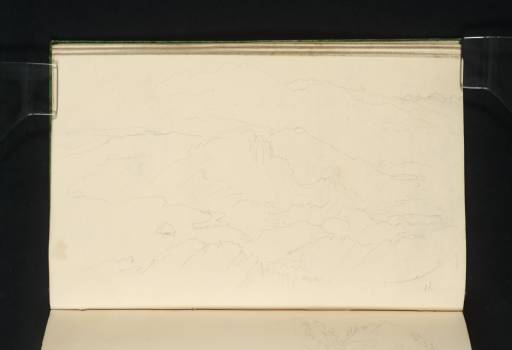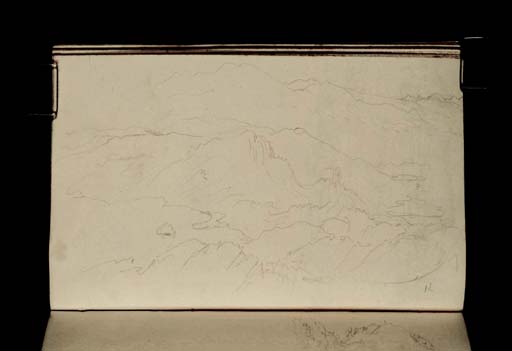Joseph Mallord William Turner Loch na Cuilce and Loch Coruisk from Sgurr na Stri 1831
Image 1 of 2
Joseph Mallord William Turner,
Loch na Cuilce and Loch Coruisk from Sgurr na Stri
1831
Joseph Mallord William Turner 1775–1851
Folio 38 Verso:
Loch na Cuilce and Loch Coruisk from Sgurr na Stri 1831
D26511
Turner Bequest CCLXX 38a
Turner Bequest CCLXX 38a
Pencil on white wove paper, 125 x 201 mm
Inscribed in pencil by Turner ‘K’ bottom right
Inscribed in pencil by Turner ‘K’ bottom right
Accepted by the nation as part of the Turner Bequest 1856
References
1909
A.J. Finberg, A Complete Inventory of the Drawings of the Turner Bequest, London 1909, vol.II, p.869, CCLXX 38a, as ‘Loch, with mountains.’.
1980
Gerald Finley, Landscapes of Memory: Turner as Illustrator to Scott, London 1980, pp.134 reproduced pl.60, 137.
1993
Mungo Campbell, A Complete Catalogue of Works by Turner in the National Gallery of Scotland, Edinburgh 1993, p.77 under cat.15.
This is one of three views of Loch Coruisk on Skye from Sgurr na Stri, a mountain to the east of the loch; the other sketches are opposite on folio 39 (D26512) and on folio 75 verso (D26585). The present view looks directly west from the summit of the mountain, across the tiny Scavaig River (the outlet from Loch Coruisk which is hidden by the brow on the hill in the foreground) to the ridge of hills that make up the southern section of the Black Cuillin range. On the left is Loch na Cuilce, with the small island of Eilean Glas and the landing stage where Turner disembarked from the small boat that brought him up Loch Scavaig to the head of Loch Coruisk. Only the northern end of Loch Coruisk is visible at the right of the sketch.
Although Turner drew a more detailed sketch with more of the loch on folio 39, he actually utilised more of the present sketch for his watercolour of Loch Coriskin 1831 (The National Gallery of Scotland),1 which was prepared to be engraved to illustrate Sir Walter Scott’s The Lord of the Isles, as part of a new collected edition of his Poetical Works. As Gerald Finley has pointed out, Turner relied more on his memory of the place than on his sketches,2 but the bottom left of the present sketch was followed fairly closely for the left side of his watercolour composition which shows Loch na Cuilce and Meall na Cuilce (the rock to its north) which are both shown in this sketch. The mountains behind were re-imagined into a more triangular ridge that look as if they had been recently rent from the earth by the power of colliding tectonic plates, an effect that was probably inspired (as John Gage has pointed out) by a passage in the geologist John MacCulloch’s Highlands and Western Isles of Scotland, which Scott may have pointed out to the artist. 3 As Gage put it, MacCulloch and Turner share the characteristics of ‘sublime scale and a precision of geological description’.4 The shape of this ridge of rock may also have derived from the memory of different views of the Cuillins from around Loch Coruisk. Although the shape is wrong or exaggerated as seen from Sgurr na Stri, it is quite close to Sgurr Alisdair as seen from the level of the loch.
Above the main sketch Turner repeated the outline of the mountain peaks at the west of Loch Coruisk, attempting to render their appearance more accurately and to extend the view to the north.
Thomas Ardill
March 2010
How to cite
Thomas Ardill, ‘Loch na Cuilce and Loch Coruisk from Sgurr na Stri 1831 by Joseph Mallord William Turner’, catalogue entry, March 2010, in David Blayney Brown (ed.), J.M.W. Turner: Sketchbooks, Drawings and Watercolours, Tate Research Publication, December 2012, https://www


